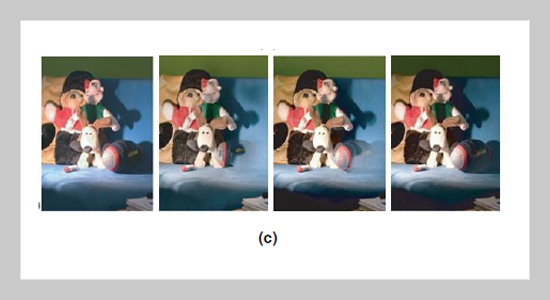REFERENCES
- [1]Shoulin Y, Ye Z. “Singular value decomposition-based anisotropic diffusion for fusion of infrared and visible images”, International Journal of Image and Data Fusion, pp: 146-163 (2018). doi: 10.1080/19479832.2018.1487886
- [2]Chen, H.-J. Feng, Z.-H. Xu, et al. “Fast detail-preserving exposure fusion”, Journal of Zhejiang University, 49(6), pp:1048-1054, (2015). doi: 10.3785/j.issn.1008-973X.2015.06.007
- [3]Kuo Chen, Yueting Chen, Huajun Feng, et al. “Detail Preserving Exposure Fusion for a Dual Sensor Camera”, Optical Review, 21(6), pp: 769-774, (2014). doi: 10.1007/s10043-014-0126-6
- [4]Ma J, Ma Y, Li C. “Infrared and visible image fusion methods and applications: A survey”, Information Fusion, 45, pp: 153-178, (2019). doi: 10.1016/j.inffus.2018.02.004
- [5]Jing Gao, Peng Li, Zhikui Chen. “A canonical polyadic deep convolutional computation model for big data feature learning in Internet of Things”, Future Generation Computer Systems, 99, pp: 508-516 (2019). doi: 10.1016/j.future.2019.04.048
- [6]Qingchen Zhang, Changchuan Bai, Laurence T. Yang, Zhikui Chen, Peng Li, and Hang Yu. “A unified smart Chinese medicine framework for healthcare and medical services”, IEEE/ACM Transactions on Computational Biology and Bioinformatics, (2019). doi: 10.1109/TCBB.2019.2914447
- [7]Peng L, Chen Z, Yang L T, et al. “Deep Convolutional Computation Model for Feature Learning on Big Data in Internet of Things”, IEEE Transactions on Industrial Informatics, 14(2), pp:790 - 798 (2018). doi: 10.1109/TII.2017.2739340
- [8]Gao Z, Zhang C. “Texture clear multi-modal image fusion with joint sparsity model”, Optik - International Journal for Light and Electron Optics, 130, pp: 255-265, (2017). doi: 10.1016/j.ijleo.2016.09.126
- [9]Ayush Dogra, Bhawna Goyal, Sunil Agrawal. “From Multi-scale Decomposition to Non-multi-scale Decomposition Methods: A Comprehensive Survey of Image Fusion Techniques and its Applications”, IEEE Access, 5, pp: 16040 - 16067 (2017). doi: 10.1109/ACCESS.2017.2735865
- [10]Jing Gao, Jianzhong Li, and Yingshu Li. “Approximate event detection over multi-modal sensing data”, Journal of Combinatorial Optimization, 32, pp: 1002-1016, (2016). doi: 10.1007/s10878-015-9847-0
- [11]Qingchen Zhang, Changchuan Bai, Zhikui Chen, et al,. “Deep learning models for diagnosing spleen and stomach diseases in smart Chinese medicine with cloud computing”, Concurrency and Computation: Practice and Experience, (2019). doi:: 10.1002/cpe.5252
- [12]Shoulin Yin, Ye Zhang, Shahid Karim. “Large Scale Remote Sensing Image Segmentation Based on Fuzzy Region Competition and Gaussian Mixture Model”. IEEE Access. 6, pp: 26069-26080. (2018). doi: 1109/ACCESS.2018.2834960
- [13]Jiao Du, Weisheng Li, Bin Xiao. “Anatomical-Functional Image Fusion by Information of Interest in Local Laplacian Filtering Domain”, IEEE Transactions on Image Processing, 26(12), pp: 5855-5866 (2017). doi: 10.1109/TIP.2017.2745202
- [14]Li P, Chen Z, Yang L T, et al. “An Incremental Deep Convolutional Computation Model for Feature Learning on Industrial Big Data”, IEEE Transactions on Industrial Informatics, 15(3), pp. 1341-1349, (2019). doi: 10.1109/TII.2018.2871084
- [15]Li P, Chen Z, Yang L T, et al. “An Improved Stacked Auto-Encoder for Network Traffic Flow Classification”, IEEE Network, 32(6):22-27, (2018). doi: 10.1109/MNET.2018.1800078
- [16]Shoulin Yin, Ye Zhang and Shahid Karim. “Region search based on hybrid convolutional neural network in optical remote sensing images”, International Journal of Distributed Sensor Networks, 15(5), (2019). doi: 10.1177/1550147719852036
- [17]Teng Lin, Hang Li and Shoulin Yin. “Modified Pyramid Dual Tree Direction Filter-based Image De-noising via Curvature Scale and Non-local mean multi-Grade remnant multi-Grade Remnant Filter”, International Journal of Communication Systems. 31(16), (2018). doi: 10.1002/dac.3486
- [18]Wu H, Gu X. “Max-Pooling Dropout for Regularization of Convolutional Neural Networks”, International Conference on Neural Information Processing, pp: 46-54, (2015). doi: 10.1007/978-3-319-26532-2_6
- [19]Xin-Long L, Hong-Wei Y I. “Improved Multi-exposure Image Pyramid Fusion Method”, Acta Photonica Sinica, 48(8), (2019). doi: 10.3788/gzxb20194808.0810002
- [20]Kede Ma, et al. “Multi-Exposure Image Fusion by Optimizing A Structural Similarity Index”, IEEE Transactions on Computational Imaging, 4(1), pp:60-72, 2018. doi: 10.1109/TCI.2017.2786138
- [21]Jinhua Wang, Weiqiang Wang, Bing Li, et al. “Exposure fusion via sparse representation and shiftable complex directional pyramid transform”, Multimedia Tools & Applications, 76(14), pp: 15755–15775, (2017). doi: 10.1007/s11042-016-3868-2
- [22]Zhi-Feng Xie, Yu-Chen Guo, Shu-Han Zhang, et al. “Multi-Exposure Motion Estimation Based on Deep Convolutional Networks”, Journal of Computer Science and Technology, 33, pp: 487-501 (2018). doi: https://doi.org/10.1007/s11390-018-1833-4









